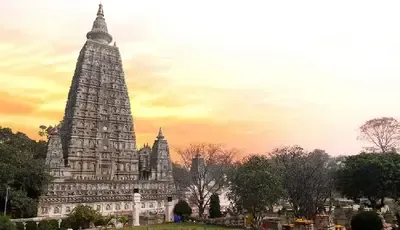

India, with its rich spiritual heritage, is home to some of the world’s most iconic Buddhist temples. For seekers of peace and enlightenment, these sacred spaces offer not only a deep spiritual experience but also a journey through centuries of cultural, religious, and architectural brilliance. These holy sites stand as living centers of knowledge, prayer, and tradition—each a remarkable blend of devotion and artistry.
Every Buddhist shrine in India radiates serenity and wisdom. From the ancient ruins of Bihar to the tranquil valleys of Himachal Pradesh, each temple tells its own story of faith, architectural grandeur, and cultural diversity. Visiting them provides a unique glimpse into Buddhist philosophy while allowing one to travel back in time through India’s layered past.
# Mahabodhi Temple, Bihar
The Mahabodhi Temple, a towering symbol of Buddhism, marks the very spot where Siddhartha Gautama attained enlightenment nearly 2,500 years ago, becoming the Buddha. Located in Bodh Gaya, this UNESCO World Heritage Site is among the most revered pilgrimage destinations for Buddhists worldwide.
The earliest shrine was built here in the 3rd century BCE by Emperor Ashoka, who later embraced Buddhism. The present structure, dating back to the 5th–6th century CE, is a stunning example of medieval Indian brick architecture, with its majestic pyramidal spire rising 55 metres high.
Set amidst peaceful gardens, the temple complex features smaller stupas and statues narrating tales of devotion. At its heart stands the sacred Bodhi Tree, a descendant of the original under which the Buddha meditated. A visit here is a profound blend of spirituality, history, and cultural learning.
# Mahaparinirvana Temple, Uttar Pradesh
Situated in Kushinagar, the Mahaparinirvana Temple is one of Buddhism’s most significant pilgrimage sites. It is believed to be the place where the Buddha attained Mahaparinirvana—final liberation—in 482 BCE.
The temple’s most iconic feature is a colossal 20-foot-long reclining statue of the Buddha, symbolizing his release from the cycle of birth and rebirth. Surrounding the shrine are stupas and monasteries, including the Rambhar Stupa, said to be the cremation site of the Buddha. Ancient writings and artifacts add to the site’s historical and spiritual depth, making it a must-visit for devotees and history enthusiasts alike.

# Namgyal Monastery, Himachal Pradesh
Namgyal Monastery, in McLeod Ganj near Dharamshala, is the personal monastery of the 14th Dalai Lama and the largest center of Tibetan Buddhism outside Tibet. Originally founded in 1575 by the third Dalai Lama, it was re-established in India after the Tibetan uprising of 1959.
This vibrant institution is dedicated to preserving Tibetan culture, teachings, and rituals in exile. Monks here study Buddhist philosophy, meditate, and perform rituals, many of them assisting the Dalai Lama in his spiritual duties. Open to both monks and visitors, the monastery offers a serene environment for meditation and learning about Tibetan Buddhism.
# Tawang Monastery, Arunachal Pradesh
Perched at an altitude of 10,000 feet in Arunachal Pradesh, Tawang Monastery is India’s largest and the world’s second-largest monastery, after Lhasa’s Potala Palace. Established in 1680–81 by Merak Lama Lodre Gyatso, it belongs to the Gelugpa sect of Tibetan Buddhism.
Home to over 300 monks, the monastery functions as both a learning center and a place of worship. Its fortress-like structure, with tall walls and spacious courtyards, houses a 28-foot-tall golden statue of the Buddha as its highlight. The library here preserves ancient Buddhist texts, while the panoramic Himalayan views make the visit truly awe-inspiring.
# Tabo Monastery, Himachal Pradesh
Located in the remote Spiti Valley, Tabo Monastery is one of India’s oldest surviving Buddhist sites. Founded in 996 CE by King Yeshe-O of the western Himalayan Guge Kingdom, it is often called the “Ajanta of the Himalayas” for its exquisite wall paintings and murals.
Unlike most hilltop monasteries, Tabo lies on the valley floor, surrounded by stark, barren landscapes that amplify its spiritual aura. The complex includes nine temples, numerous stupas, and meditation caves. Its main temple, Tsuglagkhang, houses thousand-year-old manuscripts, sculptures, and murals, making Tabo a living museum of Buddhist art and history.

# Rumtek Monastery, Sikkim
Just outside Gangtok, Sikkim, lies Rumtek Monastery, the seat of the Karma Kagyu lineage of Tibetan Buddhism. Built in the 16th century by the 9th Karmapa, it is a replica of the Tsurphu Monastery in Tibet.
Surrounded by lush greenery, Rumtek is both a spiritual and cultural hub. Its Golden Stupa houses the relics of the 16th Karmapa, drawing pilgrims and visitors from across the world. The monastery also comes alive during Tibetan New Year, with vibrant festivals and masked dances. A visit here combines spirituality with a deep dive into Sikkim’s Buddhist heritage.
# Wat Thai Temple, Uttar Pradesh
Located in Kushinagar, the Wat Thai Temple reflects the deep cultural bond between India and Thailand. Built in the 1990s to commemorate the Thai King’s visit, the temple combines Thai and Indian architectural styles, with golden spires, intricate carvings, and sculptures depicting scenes from the Buddha’s life.
Kushinagar itself is one of the four most sacred Buddhist pilgrimage sites, believed to be where the Buddha attained Mahaparinirvana. With its serene meditation hall, landscaped gardens, and striking design, Wat Thai Temple offers visitors a peaceful haven for prayer and contemplation.
# Hemis Monastery, Ladakh
Nestled in Ladakh’s rugged mountains, Hemis Monastery is one of the largest and most famous Buddhist monasteries in India. Established in 1672 under King Sengge Namgyal, it is associated with the Drukpa lineage of Tibetan Buddhism.
The monastery is celebrated for its vast prayer hall, intricately painted walls, and priceless collection of thangkas, statues, and manuscripts. Each summer, Hemis hosts the world-renowned Hemis Festival, with vibrant mask dances and cultural performances. Its spiritual atmosphere, combined with breathtaking Himalayan scenery, makes Hemis a must-visit.